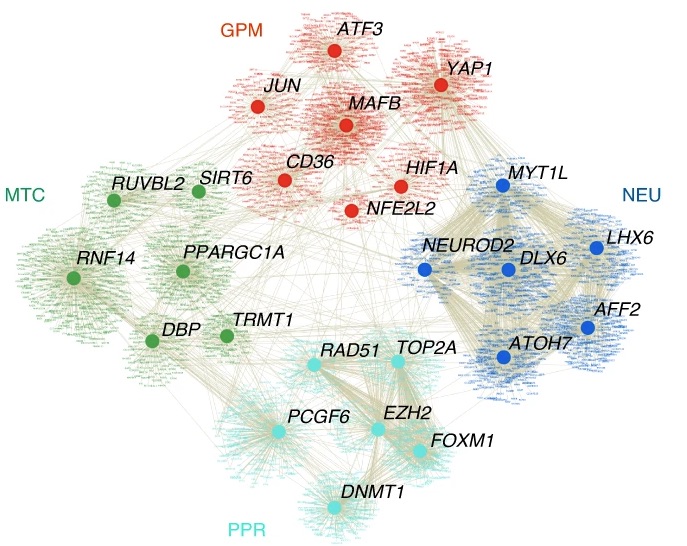Computational and Quantitative Biology PhD
Antonio Iavarone - Classification and precision therapy of glioblastoma

Venue: Teams
ABSTRACT
The overarching theme of our research program is the dissection of the role of proteins and networks (master regulators) that drive phenotypic states in normal and cancer cells of the brain. We use global and unbiased approaches to identify the genetic and transcriptional drivers of an obscure but incredibly important aberrant phenotype in brain tumors, the mesenchymal transformation of human high‐grade glioma. This phenotype endows one of the most lethal types of human cancer (the glioblastoma multiforme, GBM) with extremely aggressive features such as the ability to invade the normal brain and form new blood vessels.
In recent work we have identified and validated two transcription factors (Stat3 and C/EBP-beta) that, on their own, are necessary and sufficient to maintain the mesenchymal signature of high‐grade glioma.
The dissection of transcriptional networks has provided us with invaluable information on the nature of the master regulators that control whole signatures of gene expression. However, cancer is a genetic disease and we recognized that the reconstruction of transcriptional networks should be integrated with the development of systems approaches aimed at identifying novel cancer‐driving genetic alterations. The availability of massively parallel sequencing technologies has revolutionized the field of cancer genetics. By analyzing the whole transcriptome of human glioblastoma, we recently discovered that a subgroup of GBM patients is defined by the presence of gene fusions of FGFR and TACC genes in their tumors.
The identification of FGFR‐TACC fusions in GBM patients and the elucidation of the mechanistic consequences triggered by the fusion proteins for development of brain tumors have allowed us to translate these findings to preclinical models of the disease and design clinical trials in GBM patients harboring FGFR‐TACC fusions. This work provides the first example of an oncogenic and recurrent gene fusion in human GBM and leads our research towards the goal of personalized cancer translation.
Current areas of research include the mechanism of oncogenic transformation by FGFR‐TACC fusion proteins, validation and modeling novel glioblastoma gene fusions in the mouse and identification of novel driver genetic alterations relevant to the maintenance of phenotypically recognizable subtypes of brain tumors. A few examples of the recent work in the Iavarone’s laboratory are:
- the identification of the master regulators of the most aggressive subtype of GBM called the mesenchymal subgroup (Nature, 463: 318-325, 2010).
- The report of the first example of recurrent, oncogenic and addicting gene fusions in GBM (Science 337:1231-1235, 2012). These gene fusions are now being targeted with FGFR inhibitors in clinical trial enrolling GBM patients harboring FGFR-TACC fusions (Clin Cancer Res. 21:3307-3317, 2015).
- The development of experimental pipelines for the identification of driver genetic alterations in malignant brain tumors (Nature Genetics, 45:1141-1149, 2013).
- Leader of the Atlas-TCGA Analysis Working Group for pan-glioma (LGG and GBM, Cell, 164:550-563, 2016).
- The identification of the mechanism of oncogenic action of FGFR-TACC fusions in human cancer (Nature, 553:222-227, 2018)
SPEAKER
Antonio Iavarone, is Professor of Neurology and Professor of Pathology and Cell Biology at the Institute for Cancer Genetics of Columbia University (NYm USA). Antonio has given significant contributions to understand the mechanisms of gliomagenesis. The overarching theme of his research program is the dissection of the role of proteins and networks (master regulators) that drive phenotypic states in normal and cancer cells of the brain. His lab uses global and unbiased approaches to identify the genetic and transcriptional drivers of an obscure but incredibly important aberrant phenotype in brain tumors, the mesenchymal transformation of human high-grade glioma. By analyzing the whole transcriptome of human glioblastoma, Iavarone's Lab recently discovered that a subgroup of GBM patients is defined by the presence of gene fusions of FGFR and TACC genes in their tumors. The identification of FGFRÃ-TACC fusions in GBM patients and the elucidation of the mechanistic consequences triggered by the fusion proteins for development of brain tumors have allowed us to translate these findings to preclinical models of the disease and design clinical trials in GBM patients harboring FGFRÃ-TACC fusions. Current areas of research include the mechanism of oncogenic transformation by FGFRÃ-TACC fusion proteins, validation and modeling novel glioblastoma gene fusions in the mouse and identification of novel driver genetic alterations relevant to the maintenance of phenotypically recognizable subtypes of brain tumors.
HOW TO ATTEND
The seminar will be online using TEAMS. Please register for the seminar. We will send you an invite with the link to the seminar.
All Dates
- Friday, 29th January 2021 17:00
Powered by iCagenda





